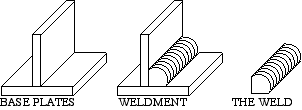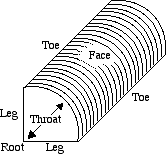


WELDING PROCESS VARIABLES

THE KEY TO BASIC WELDING
Second only to safety, quality is the most important endeavor in any welding operation. In order to produce quality welds you must prevent or eliminate weld defects; to accomplished this you must control the Welding Process Variables.WELDING PROCESS VARIABLES:
Things (parameters) that you set, select, adjust, balance, change, manipulate, tweeque or otherwise have control over to assure the intergity and affect or influence the outcome or results of the welding operation. Each welding operation has its own set of variables that must be identified, controlled and mastered. When you master the process variables, you will indeed produce outcomes that are: advantageous, predictable, favorable, repetitive, reliable and profitable.With the rapid advancement of Automation and Computerization in welding, so grows the list of process variables.. The lists below may be incomplete or out-dated in some cases.
- WELDING PROCESS VARIABLES ( Example Basics )
THE WELD
1.
The Alloy or metals type
2.
Metal shape
3.
Metal Thickness
4.
Weld Type, Joint, Position
5.
Joint Geometry, Root Opening, Backing
6.
Technique
7.
Prep.
8.
Post treat
SHIELDED METAL ARC WELDING *** [ SMAW ] ***
1.
Amperage
2.
Polarity
3.
Electrode type
4.
Electrode size ( diameter )
5.
Arc length
6.
Electrode angle
7.
Travel Speed
8.
Technique ( Whip, oscillate, drag, weave )

OXYACETYLENE WELDING *** [ OAW ] ***
1.
Tip size
2.
Acetylene pressure
3.
Oxygen pressure
4.
Flame balance
5.
Flame distance to work
6.
Flame angle
7.
Travel speed
8.
Rod diameter

GAS METAL ARC WELDING *** [ GMAW ] ***
1.
Amperage
2.
Voltage
3.
Wire type
4.
Wire size
5.
Wire speed
6.
Gas type
7.
Flow rate
8.
Metal transfer
9.
Travel speed

GAS TUNGSTEN ARC WELDING *** [ GTAW ] ***
x
1.
Amperage
2.
Polarity
3.
High-frequency
4.
Tungsten type
5.
Tungsten diameter
6.
Gas type
7.
Flow rate
8.
Cup size
9.
Rod type
10.
Rod diameter

THE WELD
 ---
---
![]()
The weld can be diagramed into five parts; this is useful in examining the weld for defects.
The
Face
----
(
Porosity, Cracks ) The Toe
-----
(
Undercut, Overlap ) The Leg
----
( Size ) The
Root
--
(
Penetration, Fusion ) The Throat
--(
Contour, Depth )


![]()
When any two objects are fitted together for welding they form one of five possible joints

![]()
Whenever possible it is practical to perform all welding operations in the flat position.
If the weldment is not performed flat, then it may be referred to as "out of position."
There are four possible weld positions.

The position is determined by the inclination of the weld axis and the rotation of the weld face.
![]()